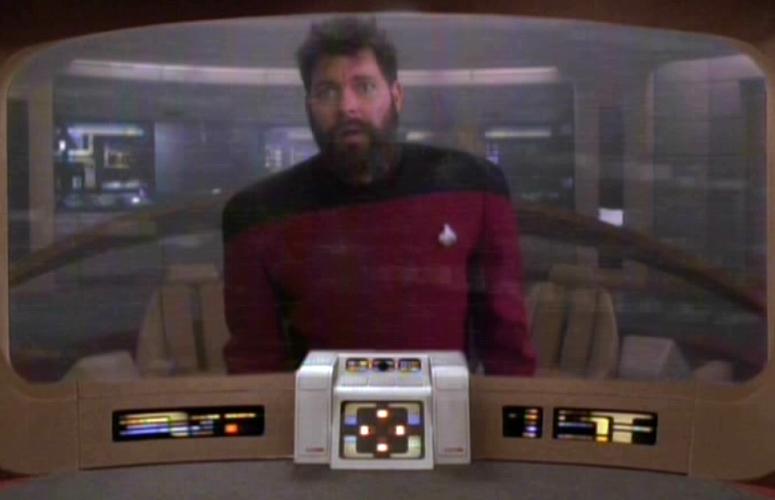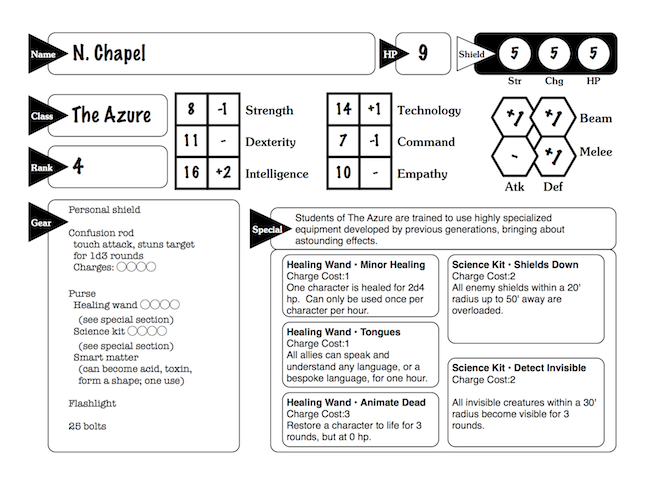Trekpocalypse Now
At YAPC::NA in Austin this year, I ran a sorta-D&D game on game night. I have been meaning to write it up nicely, but I think it’s just not going to happen, so I’m going to write it up badly. Here we go…
The Ward
The PCs are wardens, residents of the Ward, a strange stronghold of almost perpetual night, along with two hundred others. The elite protect and provide for the rest of the populace. Sometimes a few venture out of the ward, but rarely and often never to return. Beyond the ward are the Sunlit Lands, as far as most wardens ever travel.
The Golden Circle of the Ward maintains communication with distant cells, including one at the War Sactum. The War Sanctum is a small chamber where The Voice (the wardens’ oft-witnessed deity) is much more responsive and where terrible powers are accessible to those who know the right secrets. After reports of an upcoming celestial event of great importance, the War Sanctum was attacked by the Alexandrians, an aggressive group of Mogh. With no other cells of the Golden Circle able to respond, the PCs are assembled and sent. They have 3 hours.
From the Ward, the players must first pass through the Sunlit Lands.
The exact terrain of the Sunlit Lands changes from time to time, although there are a limited number of configurations it takes on. Now, it is an expansive field in a bay, surrounded by cliffs. There are huts built here and there. The sun is warm and bright. A few dozen people are scattered around, picnicking. The PCs exit the Ward through a steel blast door set into a cliff wall.
The inhabitants of the Sunlit Lands are the Hollow Men. They are pleasant, somewhat vapid people, with very few worries. They cannot leave the Sunlit Lands, having lived on its food for too long. The same is true of anyone who lives on their food for more than a few days.
The PCs know the next step is London. London is currently accessible only through an undersea tunnel — one of its less helpful locations. (“Can’t you wait a few weeks?” ask the Hollow Men, if asked) Someone will have to wade out, dive under, and get the hatch open. This leads to an expanse of metal tubing long enough for everyone to get in, but it will fill with water, though the water will dissolve as it fills. It fills fast enough that this isn’t a big help, but once the entrance is closed, things will dry off.
London is a twilit metropolis of narrow alleys and dreary weather. The streets are crowded with anxious citizens of all ranks. The PCs will, unless disguised quickly, draw attention.
The vast majority of citizens of London just want to be left alone. They will react to weird stuff by gasping or acting scandalized, but will not raise an alarm. The people to fear are the League of Yellow Men and their henchmen. The League rules the city with an iron fist, opposed only by the network of thieves and urchins run by Abdul Amir.
The game didn’t get much further than that, due to a TPK, but a few more areas stood between London and the War Sanctum.
Trekpocalypse!

The game was set aboard Enterprise (NCC-1701-D) several generations after a catastrophic space catastrophe. The challenge was to make it from Ten Forward to the battle bridge, making it through decks controlled by several of the factions now struggling for control of the ship. The Alexandrian faction of the Mogh were the final boss in this scenario, but the Yellow Men, Machine Men, and others were around. I’d started to scribble down ideas for what else I’d do if I had time. The Cult of the Immortal seemed like they’d be fun, and the nanite-possessed Skull Crushers led me to thinking about even more ridiculous backstory.
Eventually, I forced myself to stop thinking of new ideas, since I already had way too many, and get to work on some rules.
I started with the Moldvay rules, which is a pretty nice simple set of rules onto which to bolt hacks. I wanted to have distinct classes that felt like classes, weren’t too complicated, and captured at least some of the Trek flavor. I looked at stealing from Hulks & Horrors and Starships & Spacemen but I decided I didn’t quite like them.
Instead, I sketched out six (or seven) distinct classes and, rather than come up with complete rules up through level four, I just threw together characters at that level. The character sheet image, above, links to the full set of PC pregens that I made.
Attributes
PCs have six attributes:
- Strength
- Dexterity
- Intelligence
- Technology
- Command
- Empathy
Classes
The Crimson are the leaders of the wardens. They act both as warriors and priests, having the ability to influence the Voice. Each Crimson PC has a pool of Access points. They can get information or favors from the Voice by rolling 1d20 vs. 20, and they can add their total Access points to the roll, or they can spend a number of Access points equal to the level of the effect they want to achieve. The pregens all had 5 Access, meaning that all effects needed a 15 or better, but every time the PC got a guaranteed success, all subsequent attempts in the episode got harder.
The Gold Circle specialize in more powerful effects, but they take much longer. For example, the Remote Viewing power takes 3 turns to invoke — that’s a half hour! Gold Circle PCs get a number of Bright Ideas per episode, though, and these can drastically reduce the time required. The first few Bright Ideas spent on an effect change the units. After they get down to rounds, they go to turns, and after that, to instant. A power can only be used once, unless you have another Bright Idea. Powers usually have a minimum required time, usually one round. I provided two Gold Circle builds. One was a support character, with Remote Viewing, Shields Up!, Dispel Illusion, and Cornucopia. The other was a stealth attacker with access to the teleporter and a personal cloaking device.
The Azure are experts in understanding (rather than just using) the technology of past generations. They don’t have any powers on their own, but they’re the only characters who can use tech more complicated than ray guns and comm badges. Azure PCs are trained in using specific devices. Each device has a number of charges, and once they’re used up the device can’t be used again until it’s recharged, which takes … well, too long to do in the game’s three hour window.
Empath PCs have psychic powers! They’re pretty close to AD&D 2nd Edition psionicist characters. They have a pool of psi power points, and powers cost points. Their prime attributes are Command and Empathy, depending on their build. They’d probably all have some of the same powers, then some different ones. One power was Weaken Will, which lets the empathy attack the target’s effective Command stat, making them more susceptible to later powers.
The Mogh (aka Warface (get it, Worf-face?)) are Klingons. Or, I guess, part-Klingons. I like to imagine they’re all descended from Alexander and Worf, but who knows? They can regenerate 2 hp per round (but their shields stink; see below). In combat, they can switch between different stances that give them different advantages or disadvantages.
Twinlings were the final PC race, and I was very happy to include them. Why don’t we see more of those guys on the show? If I ever wrote an episode… Well, anyway, they were very much a support class. A single twinling PC is two entities, and gets two actions per round, but if either one dies, that’s it. I’d probably give the survivor a round or two to be heroic, but that’s it. All the twinlings’ powers were there to enhance the other characters’ powers. They could restore charges to devices for the Azure, repair device (or shield) damage, temporarily boost shield strength, extend the range or duration of other powers, or (and I was sad nobody used this) duplicate any device or power they’d seen used in the last day. Using any twinling power consumed a set of Spare Parts.
The Green were going to be descendants of Orions, for no good reason other than I had a bunch of other colors represented. I didn’t come up with any good ideas, though.
Combat
Everybody got two sets of attack and defense stats, one for melee and one for beam. Beam weapons have an effectively infinite range. (I guess if there’d been extravehicular combat, I’d think about that harder.) Melee weapons… well, you know.
Everybody got a shield, except for the PC with the personal cloak. Shields have a strength stat, which is the amount of damage they can absorb, in hp, before failing. They always absorb whole attacks, so when a 10 hp attack hits your 1 hp shield, you take no damage. Phew! Shields also have their own hit points, and every time they fail, they lose a hit point. As long as they’re not reduced to zero hit points, it will recharge after a few rounds in which the character takes no damage. So, if your shield is strength 5, charge 2, hp 5, then it can absorb two 4 hp attacks before failing. Then its wearer needs to stay out of the line of fire for two rounds, and the shield will be up again. This can happen five times.
The Mogh PCs have specialized shields. They have strength 1, but infinite hit points. They’re really just there to give them one attack worth of immunity while they charge into melee combat. Shooting at your enemy from full cover is dishonorable! Or, at least, not what those guys did best. The hilarious side effect of this was that the Mogh PCs always ran right into combat, thus becoming targets for friendly fire. At least one died that way. I believe the rule for friendly fire was that if you missed by more than your beam bonus, and the target was engaged in melee with your ally, you hit your ally.
Again?
It was a fun! I needed more prep and a more streamlined scenario. I would definitely run it again, and it could clearly be run as a mini-campaign and remain fun the whole time, and there’s a huge universe of stuff to steal from.
